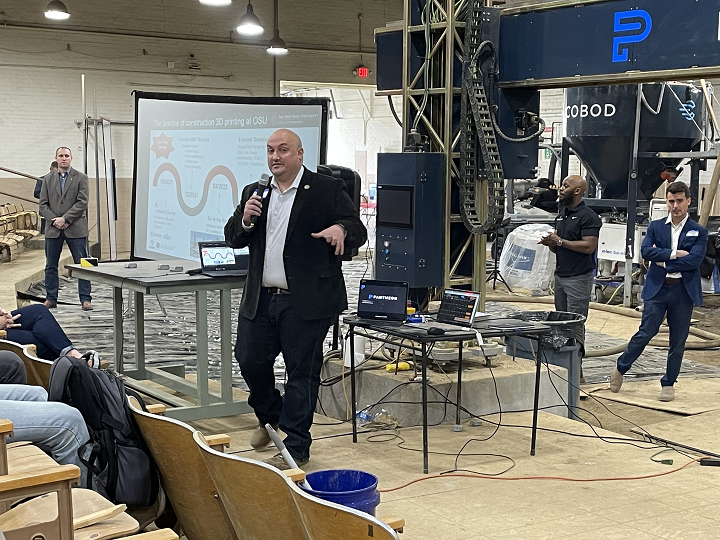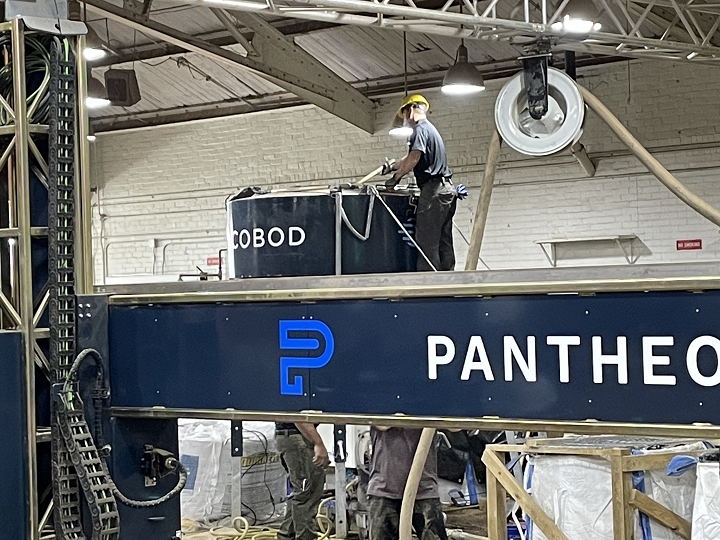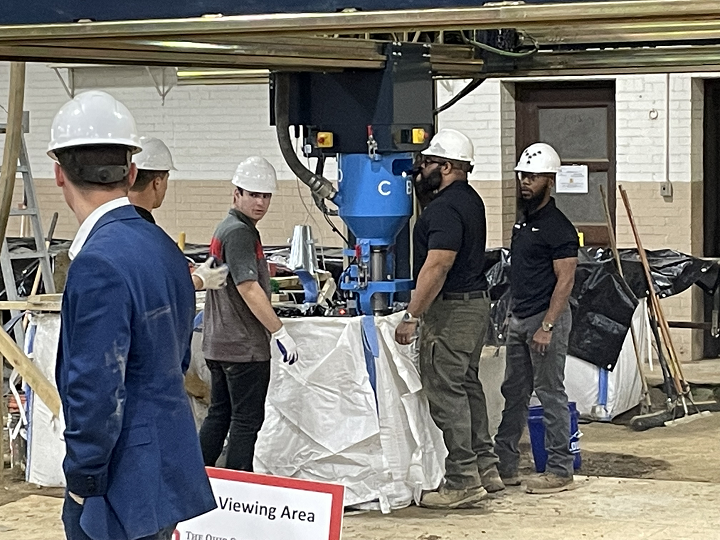This winter, The Ohio State University’s Center for Design and Manufacturing Excellence (CDME), which is one of the country’s largest additive research groups, received a COBOD BOD2 3D construction printer from Pantheon Innovative Builders as part of a multidisciplinary research cooperation. I recently had the chance to see it in action, as the CDME hosted a Construction 3D Printing Open House on campus. Nearly 300 people came to see the massive system in a former horse arena at OSU’s Plumb Hall. It was impressive for a number of reasons, starting with the fact that I’ve only ever seen a concrete construction printer setup like that outside, and it was smaller than the BOD2.
“It takes a team to do something like this,” said Ben DiMarco, Additive Manufacturing Technologist at CDME. “Each one of these footers below the printer weighs 4,000 lbs. How do you set up the printer? How do you get it up there? These are the pain points we’ve learned over the last few months, and we’re sharing these, plus the wins, with you.”
 Ben DiMarco in front of one of the printer’s “footers” and the laptop that controls the build.
Ben DiMarco in front of one of the printer’s “footers” and the laptop that controls the build.Construction 3D Printing for Workforce Development
DiMarco, who has worked at OSU for two-and-a-half years, is leading the charge on this project. Before the demonstration got started, he introduced the rest of the collaborative team, starting with CDME Executive Director Nate Ames, who explained that the CDME is an applied research center to support faculty members with their fundamental research needs, as well as “the entire community of Ohio.”
“Our model is special because, while we’re helping folks like yourself, students, companies, and government entities, we’re still really focused on the undergrads here. We hire them to work here, and there’s about 150 or so who work for us, from all departments and colleges across campus,” Ames explained. “We believe if we put them in an environment where they learn how to make stuff, with people from different backgrounds, they understand the value of why someone is different and why it’s important to have them on your team.”
As a lack of workforce development is often listed as an issue by many in the AM industry, this seems like a great model. Ames said that the CDME is “tech-agnostic,” with a staff as diverse as the undergrads it employs. According to its website, the CDME’s goal is to enhance America’s manufacturing competitiveness, and the center works with everything from AI, automation, and machining to molding and forming, cybersecurity, and, of course, 3D printing.
Tackling Concrete’s Carbon Footprint
Dr. Lisa Burris, Assistant Professor of Civil Engineering at OSU, shared some of her immense knowledge of concrete with us, and how it’s led to a “critical challenge in our nation and the world.”
“My research is focused on sustainability and durability. Concrete is the third largest emitter of carbon dioxide, and this won’t slow as the population continues to increase over time,” she explained. “So, rather than deciding not to use it, we really need to think about optimizing the material formulations we have and reducing their carbon footprints. I work with concrete that doesn’t use calcium, or uses bacteria to fill cracks, and I work with novel systems, like 3D printing. We’re going to take this from novel to real and approachable.”
 Dr. Lisa Burris
Dr. Lisa BurrisShe explained that, in the U.S., there are many old structures we can’t afford to replace, and said that “long-lasting infrastructure” is needed in this country, which is where additive construction could come in, just as we noted in an article on the Biden Administration’s initial infrastructure plans.
“We’re working to increase our ability to work with local manufacturers and aggregate suppliers and concrete producers to use local materials,” Dr. Burris said. “We’re also looking at how to test the material, how to reinforce it, how to print sustainably, and we need to understand how to move the technology from only being operated by experts to a more plug and play system. We’re working to create a smart system here at OSU that knows what’s going on with the concrete and makes decisions for the user so the average person can use it.”
Affordable Housing, Automation, and More
Ryan Kelly, the CEO and Founder of Pantheon 3D, explained that the company is interested in affordable housing, but also “wanted to give young people a way to get into the trades,” so it’s definitely a good partner for this endeavor. It was clear that the whole team is passionate about teaching, while also trying to holistically fix the pain points in the construction industry.
“You’ve got people making $50,000, $60,000 a year who can barely afford a place to live. We have to figure out a way to build faster,” Pantheon 3D’s Chief Development Officer Stephen Davis said.
Vincent Albanese, COBOD’s North American Manager of Strategic Partnerships, explained that the automation used in additive construction enables consistency, quality, and speed, noting a recent project in Saudi Arabia that the company was able to complete in two months; it would’ve taken seven months using traditional manufacturing methods.
Albanese said that Ohio was chosen for this project because “we know it’s the center of manufacturing, specifically additive manufacturing. We knew Ohio was the key.” I agree with his statement 100%.
FAQs about Construction 3D Printing
While Pantheon 3D was busy setting up the BOD2, DiMarco and the rest of the team fielded audience questions. Some were more on the logistics side, such as how long it takes to set the printer up; the answer to that one was 6-8 hours, by a trained team. Someone else wanted to know the cost of building a four-person home, and Kelly said emphatically that if anyone gives you an actual number right now, they are lying, though he did estimate that it could be 40% less than traditional construction.
“It’s a lifetime of cost-savings, through lumber versus concrete, reduction in insurance premiums, the cost gap closing,” he explained. “It’s overall lifecycle cost savings.”
 Making sure the mortar mix is consistently making its way down the pump.
Making sure the mortar mix is consistently making its way down the pump.When asked what kind of maintenance was involved with a 3D printed home, Dr. Burris said that, with concrete rather than the typical timber, the home will be “a lot less prone to durability issues, in terms of mold especially.” Someone else wanted to know about IP with the material, and Albanese said the good thing about the BOD2 is that it can use any material a customer wants. “We have an an open source batch plant, so you can develop your own mixtures,” he explained.
Initially, the team is using a proprietary mix by Quikrete, but they’re also discussing other non-proprietary formulations in order to get something as close to a ready-mix as possible. A lot of components go into the mix, which has to be flowable and able to set up in a specific amount of time as the layers build up. Another person wanted to know if they worked with waste, and Dr. Burris said that they are working with materials like corn oil. “The long-term future is to use locally sourced materials to make your own mix — sand, aggregate, things like that — and there’s research going on around the world to use other materials such as fly ash, hempcrete or local clay,” DiMarco noted.
Here’s a list of some of the other questions asked, and the responses:
- Will the system have any automation?
- COBOD is investigating the use of robotic arms.
- What happens in inclement weather?
- COBOD is testing out different enclosures, and investigating how cold it can be for the printer to still work.
- Are there building codes for 3D printed residential homes?
- ASTM is releasing a building code for 3D printed structures later this year via a joint working group with ISO and the U.S. government.
- How many layers can be printed before you have to stop and dry?
- This depends on the print area, and because the setup inside the horse arena at OSU was very small, the process was very slow; about 10-15 minutes for the bottom layer.
- How much does the printer cost?
- The cost is relative to the size of the machine. Construction is a very expensive industry, so the printer can run from $750,000 to $2 million. The CDME setup was about $700,000.
DiMarco did a great job explaining to everyone what was happening on the floor, offering plenty of process updates in between audience questions. He warned us at the very beginning that the print demonstration could fail, and then continued explaining to the crowd what was going on. The printer uses G-code, and an operator uses a laptop to control the system. DiMarco explained that the loud whirring we could all hear was the pump, and that various team members were checking the viscosity of the mixture and making sure the mortar mix was consistently making its way down the pump.
Once they determined that the material had good viscosity and was flowing normally, they were ready to start printing. To keep the material from drying out, the interior of the hose has to be fully coated.
“We used the pump system to do a 90% water-10% slurry to shoot through the hose, and then took it off to do material testing with 5-gallon buckets before hooking the hose back up,” a Pantheon 3D team member explained. “Then we extrude through the system, let it run through the actual nozzle, and actually catch layers with our hands to make sure that it’s not too runny. Then we’ll let the system go to work.”
After the third layer, the team added flaps on the side of the layer lines to smooth everything out, “almost like icing on a cake,” as DiMarco described. Flaps can’t be put on the first two layers because they will “run into the ground.” By the time they got to the fifth layer, the material was getting too runny, so the team had to stop and work on the mixture. A number of factors could have caused this issue, including flow rate and water temperature. Then, they had to flush the pump with water and purge the material, and ultimately clean out the nozzle.
“The clean-out process can take about 30 minutes to an hour,” DiMarco explained, effectively telling us that the demonstration was over. “But the purpose of today was to show you the entire process, ending with the clean-out, and that’s what happened.”
Obviously, this wasn’t the outcome the team had hoped to achieve, but it was still a very impressive and educational demonstration. 3D printed homes are coming, whether we’re ready or not.
Subscribe to Our Email Newsletter
Stay up-to-date on all the latest news from the 3D printing industry and receive information and offers from third party vendors.
You May Also Like
3D Printing News Briefs, April 13, 2024: Robotics, Orthotics, & Hypersonics
In 3D Printing News Briefs today, we’re focusing first on robotics, as Carnegie Mellon University’s new Robotics Innovation Center will house several community outreach programs, and Ugogo3D is now working...
Rail Giant Alstom Saves $15M with 3D Printing Automation Software 3D Spark
3D Spark has entered into a three-year deal with the rail giant Alstom. Alstom, a transport behemoth with annual revenues of $16 billion, specializes in the manufacture of trains, trams,...
Meltio Expands Global Reach with New Partnerships in the Americas and Europe
Spanish 3D printing manufacturer Meltio has expanded its sales network across the globe. With the addition of three new partners in the United States, Brazil, Argentina, and Italy, Meltio aims...
3D Printing Webinar and Event Roundup: April 7, 2024
Webinars and events in the 3D printing industry are picking back up this week! Sea-Air-Space is coming to Maryland, and SAE International is sponsoring a 3D Systems webinar about 3D...





































